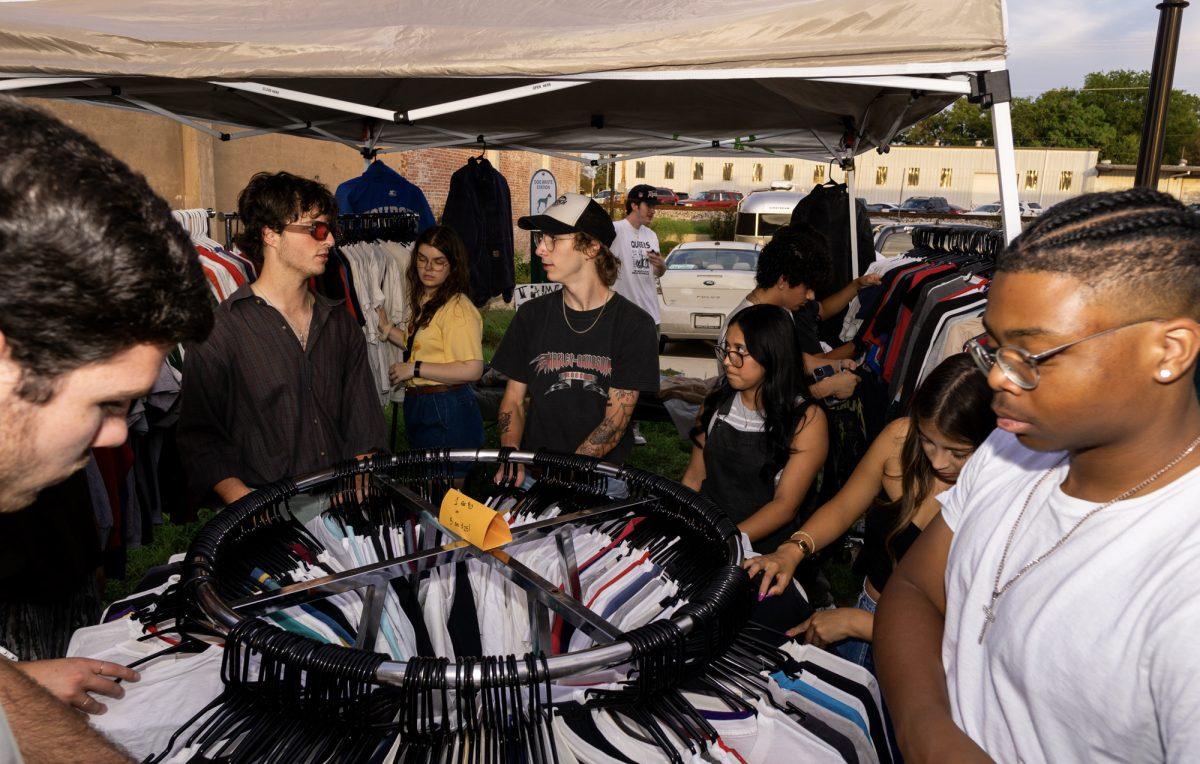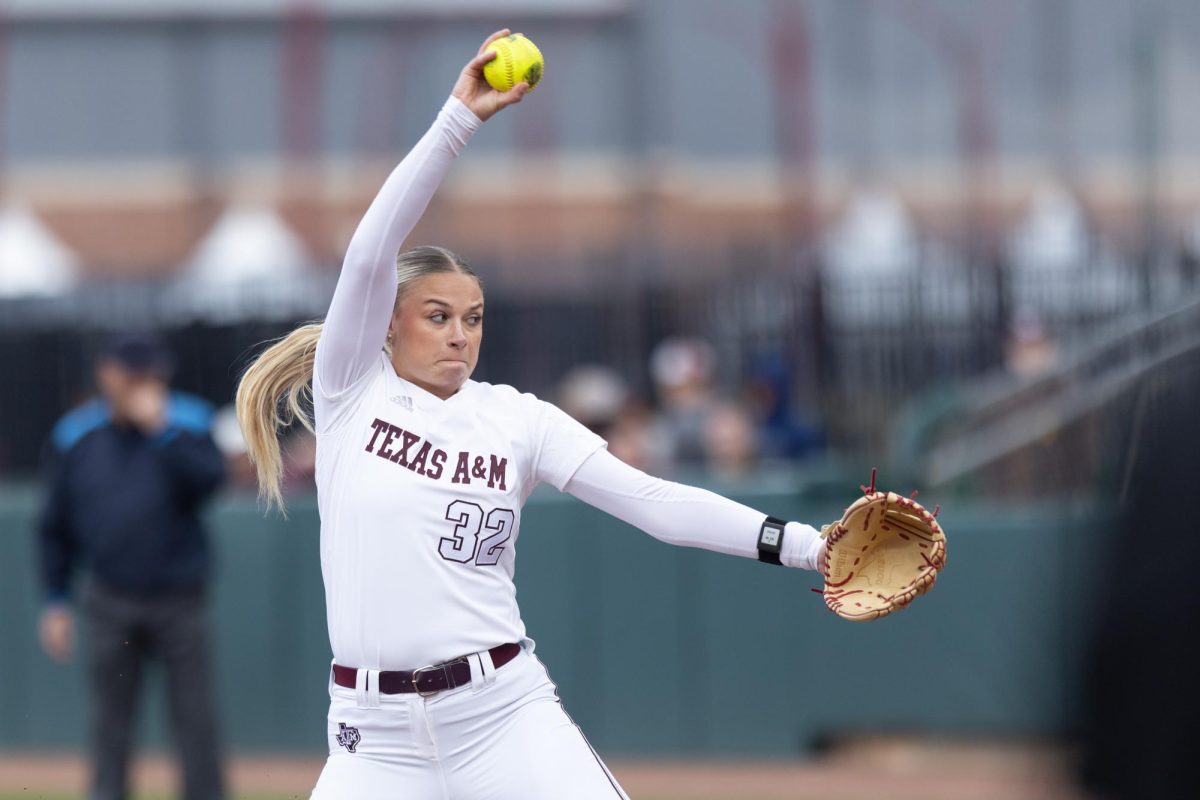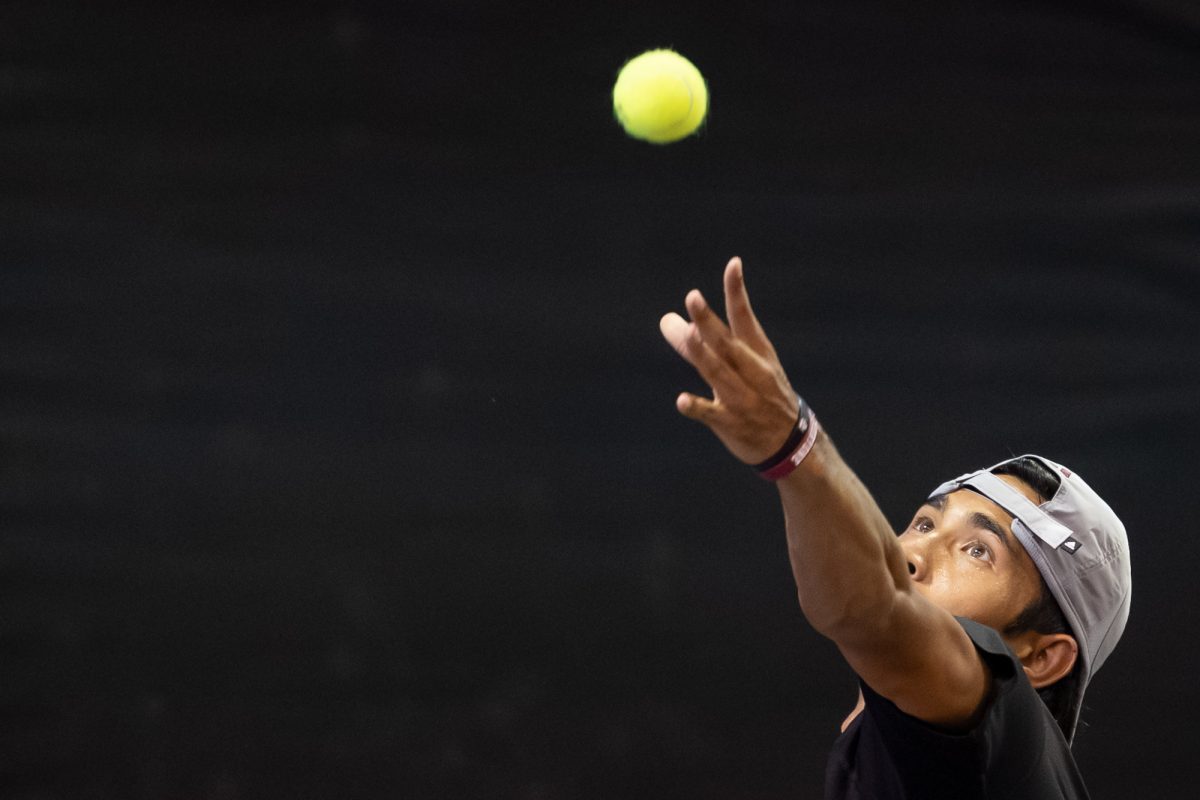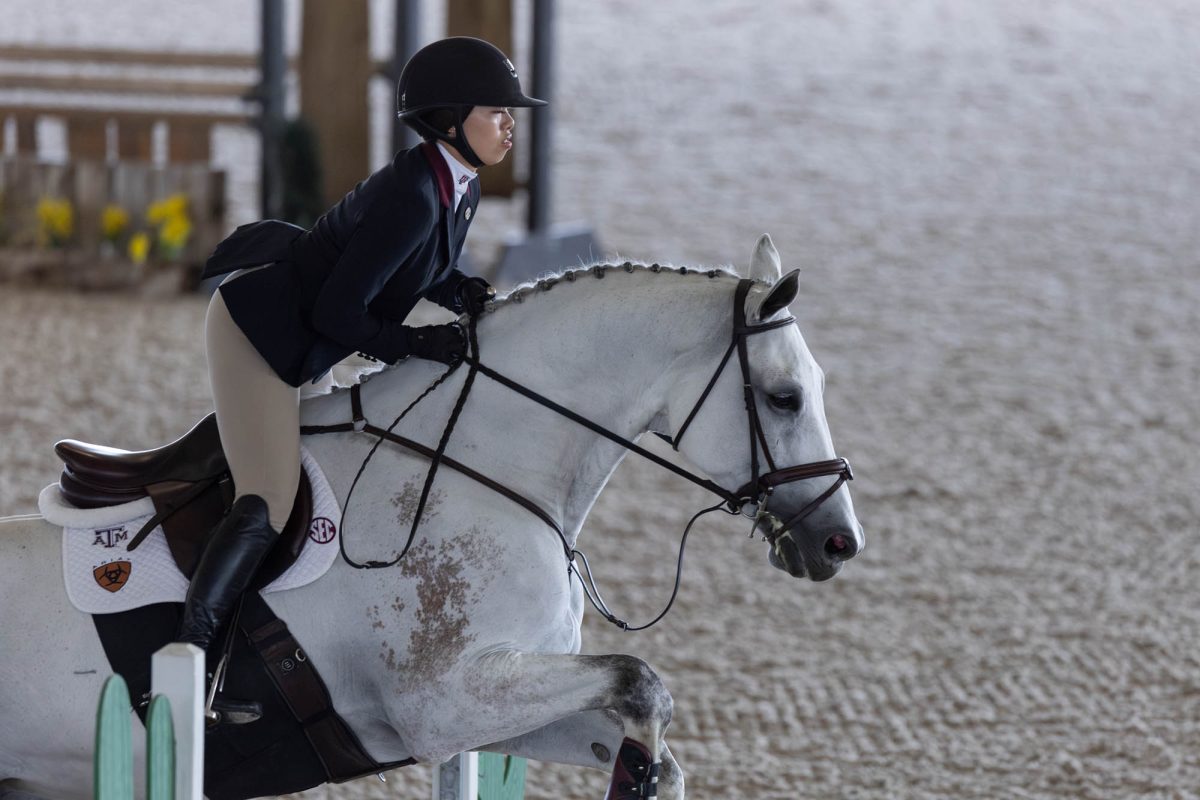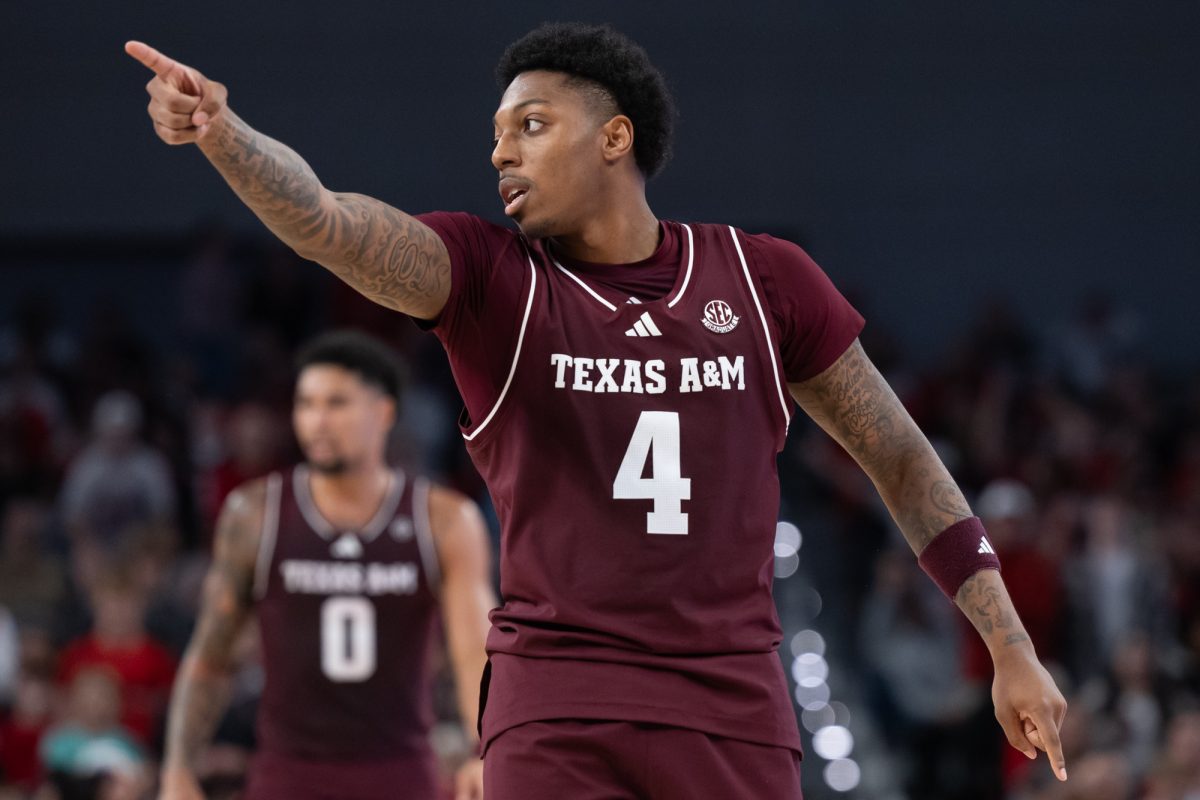Take a walk through the Memorial Student Center bookstore, and you’ll be confronted by a purchasable museum of Texas A&M branding history.
There are hoodies featuring the Vault T logo, crewnecks featuring Ol’ Sarge, as many Aggie wordmarks as you can imagine and shirts featuring all sorts of images of Reveille — both the current Reveille X and the 1930s-era logo featuring Reveille I, from back before the Queen was a rough collie.
Now, step outside the bookstore and take a stroll around campus. There’s students wearing vintage gear from every era. There’s the old T-star logo — the one that marked center court at Reed Arena through the mid-2000s — on one student’s t-shirt in Academic Plaza. And look, there’s a student crew neck with a seal reading “A&M College of Texas” from straight out of the 1940s on their way to class.
So why go old-school? Of all the newfound logos and bevels galore, why don the logos of an era most students can’t remember (or weren’t alive for)?
The answer, as always, begins with money.
Big brands and big profits
College athletics is a big business — and so is college apparel. According to an estimate by the Collegiate Licensing Company (more on them later), the college apparel market was already worth $4.6 billion back in 2015.
And with both schools and apparel companies always looking for more revenue, it’s no surprise to see them turn toward older licensed logos.
“You might buy this hat, and you might go, ‘Oh, I like the Vault T logo so I’ll buy that hat,’ or ‘I like the Lone Star logo; I’m going to buy that too,’” A&M Assistant Athletic Director Matt Watson said. “It helps your retail sales increase as well. The more options you can put out there on the logo side instead of just being stuck to one word mark, one mascot and one abbreviation logo, and that’s it.”
Watson has seen the change happen in real time. He grew up rooting for the Aggies before serving as a student equipment manager from 1990-95 and has been on A&M’s equipment staff full-time since 1997. He works directly with the football program to design its on-field equipment and oversees other sports’ equipment duties as well.
While Watson is in charge of the athletic equipment, he doesn’t control what companies like Adidas bring to the retail market.
That being said, there’s plenty of overlap between what’s seen on the field and what’s seen in stores. It’s not uncommon to see a certain item or design begin its life as a team-exclusive before a retail version later hits shelves — such as the infamous “script Aggies” hoodies.
The “script Aggies” logo was one of those vintage wordmarks that’s made a prominent return in recent years. Originally featured on basketball and baseball jerseys as far back as the 1970s, both sports — along with others, such as volleyball — brought the logo back on their current uniform sets.
“It comes down to opportunity,” Watson said. “I don’t think anybody really thought much about the script Aggies logo until it hit the basketball court. Then social media picked up on it and it blew up. When there’s an opportunity like that, it genuinely just evolves on its own.”
The hoodies got their start as a gift sent out to A&M alumni in professional sports leagues. Slowly, various programs started adding them to the sideline gear that they give to coaches and players.
Then social media got wind of it, and the demand took off from there.
“Other people are like, ‘Man, we wish that was at retail,’ so that’s where we get into a little bit of a quandary with people,” Watson said. “[If we say] ‘We can’t’ or ‘It’s only for the team,’ then they’re frustrated … when there’s something that really takes off, like the scripts, then the vendors will scramble to get that implemented as fast as they can.’”
Those retail vendors aren’t just big brands like Adidas, Nike and Champion — whole companies have made a complete business out of vintage sports apparel.
Enter small businesses
One of those companies, Streaker Sports, started with the mission to fill empty niches they saw in the sports apparel market. They made underused licenses their bread and butter, focusing on brands that didn’t have a strong apparel presence like Wiffle Ball and USA Hockey as well as defunct leagues like the North American Soccer League.
But even as bigger companies started their slow shift towards vintage licensing, Streaker saw a niche in the college market they were happy to fill.
“The brand is filling in these gaps where the so-called big brands are focusing on big leagues [and] major college licensing,” Creative Director Pete Lucchesi said. “We saw this need to fill in areas where it was a little more niche, as far as the college space.”
The company’s Heritage Collection is a line of vintage apparel for colleges throughout the Northeast. The collection began with Boston University, and the success of the Terriers’ vintage collection led other schools, like Northeastern, to approach Streaker Sports themselves.
“When you do a vintage program, all of a sudden you’re introducing these really cool marks that some people have never seen before,” Lucchesi said. “And some alumni remember them for when they were in school or when they were growing up. It reinvigorates a school’s apparel collection to add those vintage pieces.”
Streaker, along with other vintage brands like Homefield Apparel and Charlie Hustle, have seen its retro niche resonate with changing consumer tastes.
“Where we found success, why people like our products is because all of our art is hand-drawn,” Lucchesi said. “Like they used to do it back in the [19]60s and [19]70s, before there was computer-aided design. So that’s how we’re creating the art, and we’re adding that distressing to the graphic. It feels like something truly from a different era, and I think people have really grasped that.”
To get those pieces from a bygone era, it takes both physical and digital research. eBay, with its thousands of pieces of memorabilia, is one of the first places Lucchesi and his team look for logos to recreate. Collectors’ forums are another favorite target.
But the best research comes from getting their boots on campus.
“We’ll go into the archive departments and spend a day or two looking through old files, old photographs, and some schools have old jerseys, pennants and banners.” Lucchesi said. “We’ve found a lot of the best stuff by actually going to the campuses and doing research on campus.”
Their sales prove that Streaker, Homefield and other vintage college apparel companies have found a hit among fans. But not everyone is satisfied.
Some people want the originals.
The only one in town
A typical business day for Graysen Day, owner and operator of @thriftstation.htx on Instagram, consists of diving through barrels of clothes at secondhand shops across College Station and the Houston area in search of a clothing item that a college student will love — and pay for.
“I go to the Goodwill bins, and I’ve got to go through a mountain of clothes to maybe find one good piece a day,” Day said. “They’re not pieces you come across much, and they’re definitely not pieces that you go online and buy multiples of.”
Day focuses his search on the vintage items college students are typically interested in. Currently, that includes vintage NASCAR items, old Harley Davidson gear and a lot of vintage sports apparel — and when looking for what college students enjoy, college apparel is high on the list.
But why buy from Day, either online through his Instagram page or at one of the weekend vintage markets that he is a vendor for, rather than get a brand new piece with the same vintage logo? Day says exclusivity plays a role.
“You’re wearing a piece that you bought from a thrift store and you’re thinking, ‘Hey, I’m the only one in town who has this,’” Day said. “Especially if you buy a single stitch, old, unique piece — a true vintage piece. You’re probably going to be the only one in town with that exact piece, while if you go to C.C. Creations, they’re just busting out hundreds of them.”
Day also says that Bryan-College Station has seen an explosion of new options for vintage clothing, and that helped get more students interested in those pieces.
“You look at A&M two years ago, there’s zero vintage shops,” Day said. “This year alone, we’ve had Thrifted Threads come up, we’ve had Vntg Sply come up, those are two huge stores that have locations in Houston … we’ve started doing markets, and those have been going crazy. A ton of college kids come out to those.”
That hardly means the trend is exclusive to A&M, though.
“I’ve got buddies at Ole Miss that do it, I’ve got buddies at Texas Tech that do it, I’ve got buddies at the University of Arkansas that do it and I’ve got buddies in Pensacola do it, all around,” Day said. “It’s really hot right now. Two years ago, none of my friends were doing it. Now I’ve got buddies at all different colleges and universities in all different states, they’re all doing it. So it’s definitely trending at different colleges too.”
Styles change over time. But with fashion, nostalgia and money all aligning in the vintage space, don’t expect retro college apparel to go away in the near future.
“College sports are more popular than they’ve ever been,” Lucchesi said. “Every year, the college market is growing, because you’re bringing in a new crop of students. And that’s not going to stop anytime soon.”





